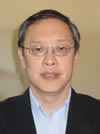 Achim Autenrieth, Principal Engineer Advanced Technology, ADVA Optical Networking
Achim Autenrieth, Principal Engineer Advanced Technology, ADVA Optical NetworkingAchim Autenrieth is currently Principle Engineer Advanced Technology in the CTO Office at ADVA Optical Networking, where he works on the design and evaluation of multilayer transport networks, control plane, and software defined networking concepts. He received his Dipl.-Ing. and Dr.-Ing. degree in Electrical Engineering and Information Technology from the Munich University of Technology, Germany, in 1996 and 2003, specializing in Information and Communication Networks. Before joining ADVA Optical Networking in June 2010, Achim was with Siemens AG and Nokia Siemens Networks, where he held the position of Head of BCS R&D Innovations. He is considered an expert in Multilayer Network Optimization and GLMPLS control plane technologies. Achim is a member of IEEE and VDE/ITG. He has also authored or co-authored more than 70 reviewed and invited scientific publications and he is technical program committee member of ECOC, DRCN, and RNDM.
 Yuval Bachar, Hardware Network Engineer, Facebook
Yuval Bachar, Hardware Network Engineer, Facebook
Yuval Bachar is a hardware network engineer at Facebook, responsible for the current and future networking hardware platform architecture and design. Prior to his role in Facebook Yuval Bachar was a Senior Director of Engineering in the CTO office in the Data Center Group at Cisco, which is responsible for the company’s data center product portfolio and next generation innovation. In this capacity, he drives and supports next generation systems’ architecture, product market positioning, and cross-Cisco product alignment. Yuval Bachar is also responsible for evangelizing new technologies around IoE and it’s integration to the data center architecture.
Prior to his role in Cisco Mr. Bachar served as VP/CTO of High-End Systems Business Unit at Juniper Networks. In this capacity, he drove Juniper’s high-end systems architecture, market, and technology positioning; including product, technology, and system level innovation and alignment across the company.
Earlier, Mr. Bachar served in a range of roles at Cisco Systems for over 12 years. In his most recent role he served as Principal Engineer/Technical Director in the Routing and Service Provider Technology Group where he was responsible for system level architecture in the Core Routing Business Unit. Previously, Mr. Bachar held management roles for groups ranging from 5 to 75 people, managing ASIC, hardware, software and test teams. Prior to that Mr. Bachar worked in a technical leader role in the Desktop Switching Business Unit responsible for the first Cisco desktop modular switch as well as the architecture for the current generation for the Cisco desktop switching products (the Catalyst 3K family). Before joining Cisco Mr. Bachar held various roles in Digital Equipment Corporation (DEC) in
the semiconductor group.
Mr. Bachar has been a contributor to the PCI standard and several IEEE standards. He holds six approved US patents in the networking and system design areas and three Cisco pioneer awards. Mr. Bachar has a BSEE from the Technion in Haifa.
Keren Bergman, Charles Batchelor Professor and Chair, Electrical Engineering, Columbia University
Keren Bergman is the Charles Batchelor Professor and Chair of Electrical Engineering at Columbia University where she also directs the Lightwave Research Laboratory (http://lightwave.ee.columbia.edu/). She leads multiple research programs on optical interconnection networks for advanced computing systems, data centers, optical packet switched routers, and chip multiprocessor nanophotonic networks-on-chip. Dr. Bergman holds a Ph.D. from M.I.T. and is a Fellow of the IEEE and of the OSA. She has authored and co-authored over 350 publications in leading journals and conferences including a current book entitled: Photonic Network-on-Chip Design; published by Springer. Dr. Bergman currently serves as the co-Editor-in-Chief of the IEEE/OSA Journal of Optical Communications and Networking.
 Brandon Collings, CTO, Optical Communications Product, JDSU
Brandon Collings, CTO, Optical Communications Product, JDSU
Brandon Collings is responsible for defining and driving the product and technology roadmaps and strategies for optical communications solutions at JDSU. Prior to JDSU, he held optical network design and development positions at Ciena and Internet Photonics, and was a Member of the Technical Staff at Bell Labs performing research on advanced optical communication network designs and non-linear performance impairments. He holds a Ph.D. from Princeton University in Electrical Engineering.
John Dunne, Chief Technology Officer, Intune Networks
John Dunne graduated from University College Dublin in Ireland in 1995 with first class honours in Electronic Engineering, and completed his PhD in 1999 at the Optoelectronics Research Centre in UCD in the field of widely tuneable semiconductor lasers. In 1999, he co-founded Intune Technologies with Tom Farrell where he has worked since and is currently the Chief Technology Officer for the company. The company moved into the network system market in 2008 and is now called Intune Networks, deploying the world's first commercial optical burst network in the US. He has been published internationally on the topics of tuneable lasers and optical burst switching network designs and has several patents as part of the invention of core IPR for the company. He has led or been involved in over 30 international research programmes on optical systems for telecoms, IT, data centres, oil and gas, metrology, industrial measurement all using tuneable lasers, optical sensors and innovative approaches to solving industry problems. In 2012, Intune spun out a company called Faztech that was successfully sold to Fugro in the optical sensor space for earth sciences solutions.
 Tom Hausken, Senior Advisor, OIDA
Tom Hausken, Senior Advisor, OIDA
With over 30 years in optoelectronics, Dr. Hausken focuses on industry activities at OSA—the Optical Society. This includes OIDA (the Optoelectronics Industry Development Association, the trade association operated by OSA) where he held a position earlier in his career. For 13 years until 2012, Dr. Hausken led market research and strategy consulting for lasers, image sensors, and a range of other photonic products at Strategies Unlimited. He was also a telecom policy analyst at the U.S. Congressional Office of Technology Assessment, and held R&D and production positions at Alcatel and Texas Instruments in photonics and electronics. He has a PhD from the University of California at Santa Barbara, in optoelectronics.
Jun-ichi Kani, Senior Research Engineer and Supervisor, NTT Access Network Service Systems Laboratories, NTT Corporation
Jun-ichi Kani joined NTT Optical Network Systems Laboratories in 1996, where he was engaged in research on terrestrial DWDM transmission systems. Since 2003, he has been with the NTT Access Network Service Systems Laboratories, where he has been engaged in the research and development of metro and access network systems. He has been participating in ITU-T and the Full Service Access Network initiative (FSAN) since 2003, and is serving as Associate Rapporteur of Question 2 (optical systems for fibre access networks) in ITU-T Study Group 15 since 2009.
Dan Kilper, Administrative Director of the Center for Integrated Access Networks
Dr. Dan Kilper is a research professor at the College of Optical Sciences, University of Arizona and the administrative director of the Center for Integrated Access Networks (CIAN), an NSF engineering research center. Previously he was a member of technical staff at Bell Labs, Alcatel-Lucent. He served as the founding technical committee chair of the GreenTouch Consortium, a global organization with over 50 members, and was the Bell Labs Liaison Executive for the Center for Energy Efficient Telecommunications at the University of Melbourne, Australia. While at Bell Labs, he received the President’s Gold Medal Award in 2004 and was a member of the President’s Advisory Council on Research. He is an adjunct professor at Columbia University and is a senior member of IEEE. Dr. Kilper has conducted research on optical performance monitoring and on transmission, architectures and control systems for transparent and energy-efficient optical networks. He holds eight patents and authored four book chapters and more than one hundred peer-reviewed publications.
 Anthony Lentine, Principal Member of Technical Staff, Sandia National Laboratories
Anthony Lentine, Principal Member of Technical Staff, Sandia National Laboratories
Anthony (Tony) Lentine received his BS and MS in Electrical Engineering from University of Illinois at Urbana Champaign and his PhD from Heriot Watt University in Edinburgh, UK (1993). He worked at Bell Laboratories until 2000, investigating the use of multiple quantum well optical modulators and switches for optical interconnects and networks for telecommunications switching systems. In 2000, he co-founded Internet Photonics, (which was acquired by Ciena Corp in 2005) which was focused on bringing optical Ethernet into metro, regional and core optical communications transport. In 2007, he joined Sandia National Labs, where he has been a key contributor to several projects, particularly those utilizing silicon photonics for low energy communications in high performance computing and other national security applications.
 Daniel Mahgerefteh, Director of Technology, Finisar Corporation
Daniel Mahgerefteh, Director of Technology, Finisar Corporation
Daniel Mahgerefteh is the Director of Technology at Finisar Corporation and leads the company’s technology road-mapping activity for next generation optical datacom products. Daniel was the co-inventor of Chirp Managed Laser (CML) technology and the Chief Technology Officer of Azna LLC, which Finisar acquired in 2007. Daniel has over 50 patents and is the co-author of numerous publications Daniel has a Ph.D. in physics (1990) from the University of Southern California.
 Lyndon Y. Ong, Principal Network Architect, Ciena Corporation
Lyndon Y. Ong, Principal Network Architect, Ciena Corporation
Dr. Lyndon Y. Ong is Principal Network Architect at Ciena Corporation and has been a major contributor to work on optical control plane. He currently chairs the Optical Transport Working Group of the Open Networking Foundation (ONF), and was involved in early joint research with Stanford University developing optical extensions to the OpenFlow interface. He is an active member of the Optical Internetworking Forum (OIF), having editing its PCE IA and previously serving on its Board of Directors and as Technical Committee Chair. He is an active member of IETF, having chaired the Signaling Transport Working Group in the past. Dr. Ong joined Ciena in 2001, after previously working at Nortel Networks, Bay Networks and Bellcore. He received his doctorate from Columbia University in 1991.
Atiq Raza, Chairman and CEO, CALIENT Technologies
Atiq Raza serves as the Chairman and Chief Executive Officer at CALIENT Technologies Inc. He also serves as a Senior Advisor at Telesoft Partners. Mr Raza has been working in various engineering leadership and senior management positions in Silicon Valley for the last 33 years.
Previously, he was the Founder and Chief Executive Officer at Raza Microelectronics Inc., which was acquired by NetLogic in October 2009 and was the Chief Technology Advisor to NetLogic prior to their merger with Broadcom. Mr. Raza was the President, Chief Operating Officer, and Director of Advanced Micro Devices (AMD). He laid the foundation of AMD’s processor roadmap, brought the AMD-K6 and Athlon™ family of processor products to the market, and established the Opteron 64-bit instruction set architecture. Mr. Raza became part of AMD's management team after the merger with NexGen, Inc. in January 1996. At NexGen, he was the Chairman and Chief Executive Officer. Prior to NexGen, Mr. Raza held various management positions at VLSI technology Incorporated, most notably the Vice President of Technology Centers. He serves as the Chairman of the Board at Validity and on the Board at eASIC, SEEO and Solantro. He serves as a Member of the Advisory Board of Silicom Ventures LLC. He also serves on the Stanford University School of Engineering Advisory Board and on Samsung's Strategic Advisory Board
Mr. Raza has several degrees, including a Master’s degree in Materials Science and Engineering from Stanford University, a Bachelor’s degree with honors in Physics from Punjab University, with a double Bachelor’s degree in Philosophy, and a Bachelor’s degree in Electrical Engineering with honors from the University of London.
 Mike Schlansker, Hewlett-Packard Labs
Mike Schlansker, Hewlett-Packard Labs
Mike Schlansker has been involved in high-performance computing for more than 30 years. Mike received his PhD from the University of Michigan and is an IEEE Fellow. Mike taught at the University of Illinois while pursuing research in high-performance computing. Mike worked for TRW, and startup company Cydrome Inc. where he developed innovative parallel architectures for high-performance computing and signal processing. Mike joined Hewlett-Packard Labs in 1989 where he initiated a research program in computer architectures and instruction-level parallelism. This work contributed to the Itanium architecture and its compilers. Most recently, Mike has been pursuing research in high-performance networking and photonic interconnects as a Distinguished Technologist at Hewlett-Packard Labs.
Ioannis Tomkos, Athens Information Technology Center
Ioannis Tomkos has been with AIT since September 2002 (serving as Professor, Research Group Head and Associate Dean). He was elected “Adjunct Professor” at the College of Optical Sciences of University of Arizona (Oct 2013) and “Adjunct Faculty Research Fellow” at the Department of Electrical and Computer Engineering at University of Cyprus (Jan 2014). In the past, he was Adjunct Faculty member at the Information Networking Institute of Carnegie-Mellon University, USA (2002 - 2010), senior scientist (1999 - 2002) at Corning Inc., USA.
Dr. Tomkos has represented AIT as Principal Investigator in about 25 EU and industry funded research projects (including 6 currently active EU projects) related with Optical Communications/Networking and Broadband Access. Together with his colleagues and students he has authored over 500 peer-reviewed archival scientific articles in journals/magazines/books (~150) and conferences/workshops (~350). His work has received over 3500 citations and his h-factor is 30. He has held many high-profile roles for IEEE and OSA. Dr. Tomkos was elected Distinguished Lecturer of the IEEE Communications Society (2007), Fellow of IET (2010) and a Fellow of OSA (2012) for “outstanding contributions in the field of transparent optical networking”.
